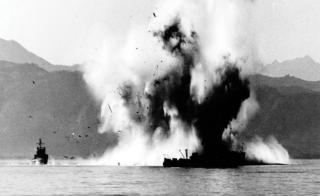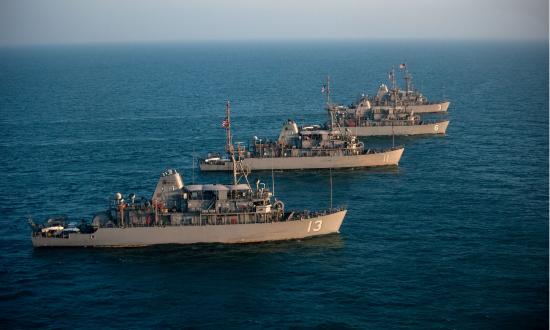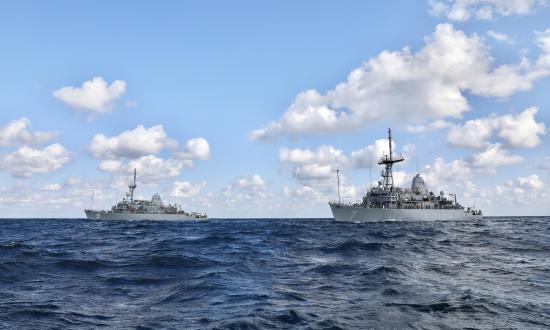The U.S. military can use naval minefields to achieve various operational ends. Many articles have pointed out the prospective advantages that could accrue from using offensive minefields to trap enemy submarines or surface ships in port, deny access to key waters, damage ships, and disrupt the complex choreography of an adversary’s amphibious assault.1 Moreover, these cost-effective weapons can create disproportionate psychological effects, forcing adversaries to make dangerous decisions or delay timely action in the face of an unknown threat lurking below the waterline.2
However, any minefield can be breached, given sufficient time and resources, using one or both of the main approaches to mine countermeasures (MCM). The first is minehunting—locating mines, primarily using sonar or short-range vision. Once detected, classified, and identified, mines can then be destroyed or preemptively detonated, typically by exploding small charges in their immediate vicinity; in some cases, mines may simply be avoided. The second is minesweeping—causing mines to explode prematurely by triggering their detonation criteria. Influence-sensitive mines can be tricked into misinterpreting a signature as a target ship, and contact mines can be hit by durable or expendable assets. (Moored mines also can be “swept” using devices that sever their cables, though MCM forces then must counter the drifting mines they have created, so this technique often is viewed unfavorably.) These minehunting and minesweeping approaches date back decades, but technological advances with respect to unmanned vehicles, sensors, and signature generators can enhance MCM performance.
Complicating Adversary MCM Efforts
For this reason, U.S. minelayers must counter both minehunting and minesweeping efforts in various ways. Using a combination of contact mines (which usually are moored) and influence mines (which usually sit on the bottom) can complicate and protract the MCM process, since the two typically need to be addressed sequentially. Contact mines usually need to be cleared from the near-surface environment before MCM forces can address the influence mines. Influence mines can be designed to look like innocuous industrial detritus, such as refrigerators or barrels, so that minehunters overlook them (or are forced to scrutinize a plethora of possible mines). Anechoic or biophilic coatings can help conceal mines, as can designs that foster burial in appropriate bottom environments. Influence mines can be set to detonate after they have been exposed to signatures from multiple ships (“ship-counting”), detonate probabilistically when exposed to ship signatures, or have intermittent dormant periods during which they are not responsive to those signatures. Clandestine reseeding of minefields can render previously cleared areas dangerous again, as can using advanced mines that can move short distances after their initial planting.
A particularly nasty, longstanding trick is designing mines specifically to target MCM forces. For example, in World War II, German forces designed mines that would detonate when exposed to appreciable amounts of light—i.e., when mines were recovered for examination—to kill critical personnel and destroy key equipment.3 Devices that specifically target MCM forces can take many other forms, limited only by the creative minds of their designers. All these approaches slow the MCM force and make it less effective.
Ideally, minelayers can lay dense, diverse fields and use clever tactics to prevent an adversary from breaching the minefield in time to achieve his objectives. However, operational circumstances may make this difficult. Minefields laid in hostile waters may need to be relatively sparse, because of the limited capacities of submarines and other clandestine minelayers, as well as the vulnerability of minelaying aircraft and ships to enemy targeting. There may be limited numbers of mines that can self-deploy over long ranges—such systems are akin to unmanned undersea vehicles (UUVs) that plant themselves and later explode, so they require a range of navigational and propulsion capabilities that make them more expensive than traditional mines. Similarly, mine-like UUVs that linger in key waters and then automatically launch torpedoes when they sense the presence of a ship likely would be costly enough that they could not be produced in the same numbers as traditional mines. An adversary with a tolerance for losses, and who is not too time-sensitive, could potentially breach a sparse minefield using brute-force methods—such as repeatedly sweeping an area with expendable assets.4
Defending Offensive Minefields
In this context, minefields need to be considered like other forms of fortifications. To prevent an adversary from overcoming them, they require active defenses. Often, naval minefields are viewed in isolation from other types of weapons, not accounting for the potential synergies between minefields and more actively directed weapons. However, a more integrated approach can be highly effective. For example, Turkish forces used a combination of naval mines and land-based heavy guns to prevent the British and French navies from breaking through the Dardanelles in 1915. The minesweepers were vulnerable to the guns, while the mines kept the rest of the fleet from being able to approach and target those guns. The Allied incursion was stymied, leading to an alternative plan to launch an amphibious assault at Gallipoli, which itself turned into a bloody stalemate. As a result, the Ottoman Empire endured until the end of the war.
Defenders of future minefields will not always have the geographic advantage of a narrow strait, but even a modest ability to degrade MCM forces can protract timelines and exacerbate losses in ways that can contribute to operational success. One way to hinder MCM operations involves using simple, inexpensive devices that employ no firepower whatsoever. All MCM operations depend heavily on accurate, precise navigation to ensure that hunting or sweeping operations thoroughly cover an area and that any mines located can be reacquired for subsequent targeting with explosive charges. Substantial numbers of small, buoyant electronic warfare jamming and spoofing devices could be periodically released upcurrent of the minefield, perhaps by a UUV. Alternatively, a low-visibility unmanned surface vehicle (USV), with just a snorkel and antenna above the waterline, could serve the same purpose.
The electronic warfare (EW) devices might be the size of a shoebox or smaller, painted dark to match the water, and have only an antenna protruding above the surface. With a thorough knowledge of what satellite-based or more localized systems the adversary could be using, such devices could mislead enemy systems and personnel regarding their precise locations, or simply reduce the accuracy of positioning, navigation, and timing (PNT) data. This can result in so-called holidays—substantial areas within a minefield in which MCM operations were not conducted and which therefore pose a risk to later transiters. If the adversary is hunting for mines, small positional errors can waste hours as divers or remotely operated vessels search in the wrong places to detonate the mines found in prior searches.
To the degree that adversaries know they are being subjected to EW, they may halt or slow MCM operations until the spoofing or jamming can be fixed. Hunting for the devices themselves would be a thankless errand, particularly if the devices had intermittent dormant periods, during which they would retract their antennae. Such devices could be vulnerable to vast arrays of nets, but there would be great uncertainty about where to position those nets. The ships emplacing them would want to operate outside the unknown boundaries of the minefield, while also operating downcurrent of the unknown location of the source of the jammers. Sharp, spring-operated cutting mechanisms on the edges of the devices could also help with the netting problem, all while keeping these devices relatively inexpensive. Searching for the UUV releasing the devices could turn into a resource-intensive and time-consuming effort, one that would have to be repeated if another UUV replaced it.
Another nonlethal approach to defending a minefield would be to release long, thin cables with high tensile strength and small, air-filled nodules scattered along their lengths to keep them just below the surface. Advances in materials science have made it possible for relatively light materials to be very strong, so that when cables got wrapped around propellers or entangled with equipment, it would take substantial time and effort to deal with the casualty. Again, a UUV or low-visibility USV could serve as the host platform to release such threats, operating upcurrent of the minefield.
Drifting mines could be used in similar fashion. Contrary to popular belief, these devices are not banned under international law. The 1907 Hague Convention requires only that such devices become harmless at most one hour after they are no longer under control.5 A UUV or fixed underwater node could burble up small, drifting contact mines just upcurrent of a key port or strait, wreaking havoc as MCM forces struggle to perform their painstakingly careful work while under attack. These drifting mines would not need to sink MCM ships. They would only need to damage them and the sensitive equipment they deploy.
Drifting mines also would have a profound psychological effect that could unnerve crews. With explosive or incendiary payloads, they could be submerged a short distance below the waterline and painted dark to minimize visibility. Those that missed targets would loudly detonate within an hour after release, adding to the disquiet as their detonations were heard nearby. Trying to counter drifting mines could absorb substantial time and resources that would otherwise be devoted to clearing the stationary minefield. Ships casting nets to trap those mines would be vulnerable to damage themselves, and they might unwittingly operate too far upcurrent to matter—or within the ragged, uncertain edges of the minefield itself.
Targeting MCM Platforms
Other weapons also could play a valuable role in defending minefields, taking advantage of the fact that MCM platforms, equipment, and expertise are generally in short supply. They also usually move slowly in predictable patterns, “mowing the grass” to thoroughly clear an area or lingering in one place as they try to address a particular mine. Many MCM platforms (including ships and helicopters) are laden with sensitive equipment and fragile because they are designed to minimize signatures to avoid accidentally detonating mines. For example, some classes of MCM ships are made of wood and fiberglass. These platforms make excellent targets. Launching a single, limited-payload missile with submunitions that rain down above the minefield could render numerous MCM platforms inoperable.
Another potential air attack would involve using a few small unmanned aerial vehicles (UAVs) as kamikazes, crashing into both MCM platforms and staging areas ashore. Even a minuscule explosive or incendiary payload could cause substantial damage. These UAVs could be launched at long ranges from a warship or land base, flying close to the water to make them difficult to detect and target. Alternatively, they could be launched from a UUV or low-visibility USV in the vicinity of the minefield.
Similarly, a UUV or low-visibility USV could surface near the minefield and shoot directly at the MCM forces. Spraying small- or medium-caliber rounds (or perhaps grenades) at fragile MCM platforms and equipment could inflict enough damage to protract MCM operations. An advantage of this type of attack is that it could directly target MCM helicopters, as well as MCM vessels and the fragile equipment that both types of platforms tow. A shooting attack might require ample communication links for active fire control and almost certainly would result in the loss of the unmanned vessel doing the shooting, though that is probably an acceptable cost. Simply having an inexpensive UUV or USV detonate in proximity to MCM forces would be another alternative, though it would need to be designed to not accidentally detonate the mines.
Overall, such tactics can make a minefield more durable against an adversary’s MCM efforts, even in hostile waters. All MCM operations require fastidious, precise use of equipment that is as fragile as it is precious. A handful of low-cost, active measures to defend offensive minefields can deny adversaries the ability to move their submarines and surface ships in a timely fashion without excessive friendly force losses. Acquiring contact and drifting mines (which are not currently in the U.S. inventory), as well as floating jammers, entangling cables with floats, and the unmanned systems mentioned above, could impede MCM operations to the point that an adversary either accepts heavy losses from mines or tries to fight with a trapped fleet. Leveraging the complementary strengths of minefields and other types of weapons would help the U.S. Navy defeat its adversaries in ways that minimize risks to U.S. forces.
1. See, for example, ADM James Winnefeld Jr., USN (Ret.), and CAPT Syed Ahmad, USN (Ret.), “The Other Mine Warfare Will Work,” U.S. Naval Institute Proceedings 144, no. 7 (July 2018); Scott D. Burleson, David E. Everheart, Ronald E. Swart, and Scott C. Truver, “The Advanced Undersea Weapon System: On the Cusp of a Naval Warfare Transformation,” Naval Engineers Journal 124, no. 1 (March 2012): 57–64; and CDRs Timothy McGeehan and Douglas Wahl, USN (Ret.), “Flash Mob in the Shipping Lane!” U.S. Naval Institute Proceedings 142, no. 1 (January 2016).
2. Scott Savitz, “Psychology and the Mined: A Case Study in Psychological Barriers to the Use of Statistical Analysis,” Military Operations Research 13, no. 1 (2008): 51–63.
3. Maurice Griffiths, The Hidden Menace (London: Conway Maritime Press, Ltd., 1981), 121–22.
4. Scott Savitz, “Rethink Mine Countermeasures,” U.S. Naval Institute Proceedings 143, no. 7 (July 2017).
5. Convention (VIII) Relative to the Laying of Automatic Submarine Contact Mines, The Hague, 18 October 1907, Article I.








